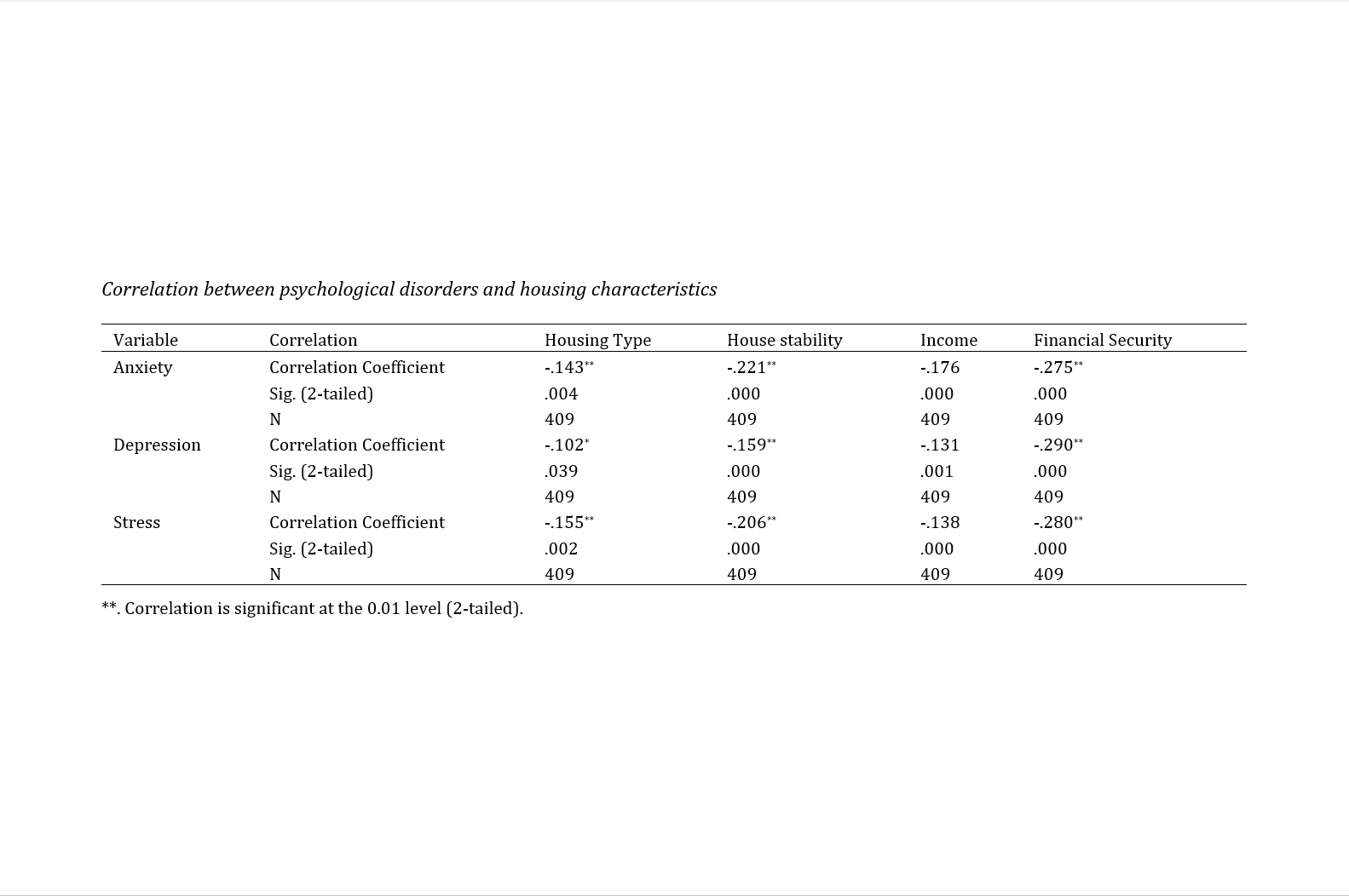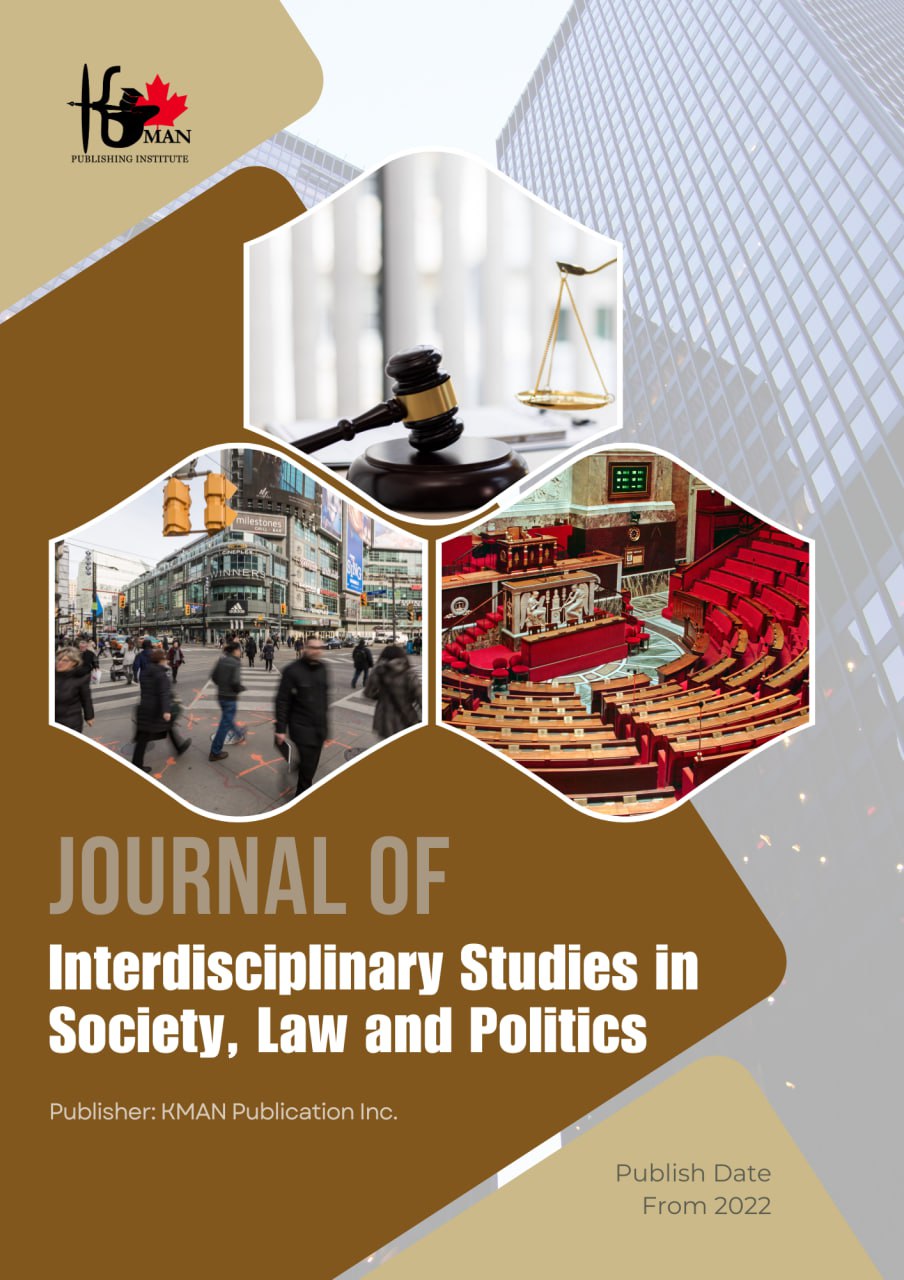The Role of Environmental and Socioeconomic Factors in Mental Health Well-being: Insight from Jordan
Keywords:
Mental Health, Environment, Socioeconomic factors, Green spaces, House stabilityAbstract
Background and aims: Depression, anxiety, and stress are among the most common psychological disorders affecting people worldwide. These conditions can influence mental well-being, resulting in sustained feelings of sadness, worry, and hopelessness. This study aims to examine the relationship between environmental factors and psychological disorders (i.e., depression, anxiety, and stress) and to explore the relationship between socioeconomic factors and these psychological disorders, methods: Sociodemographic characteristics were collected using separate data collection sheet, environmental and socioeconomic factors were measured using special Likert scale (1-5) questionnaire. Depression, anxiety, and stress were measured using the Arabic version of Depression, Anxiety, and Stress Scale - 21 items (DASS-21). Spearman's Rank Correlation was used to examine the relationship between environmental factors and (anxiety, depression, stress) and socioeconomic factors and (anxiety, depression, stress). The results were considered significant at P value ˂ 0.05, and the confidence interval (CI) was 95%. Results: The study included 409 participants. with a mean age of 36.42 years (SD ± 13.259). The majority were female (59.4%), married (57.2%), had a bachelor’s degree (46.5%), and were employed full-time (51.3%). The majority had an income of less than 500 JOD per month (53.5%). A negative significant relationship was found between Depression, anxiety, and stress and all environmental and socioeconomic factors except proximity of green areas Conclusion: Environmental and socioeconomic factors were found to be significantly associated with mental health, indicating that both environmental and personal financial safety play crucial roles in influencing psychological well-being. These findings suggest that interventions aimed at improving access to natural environments and enhancing home security may be beneficial in promoting mental health and reducing depression, anxiety and stress levels within the population.
Downloads
References
Al-Hayani, M., AboTaleb, H., Bazi, A., & Alghamdi, B. (2023). Depression, anxiety and stress in Saudi migraine patients using DASS-21: local population-based cross-sectional survey. International Journal of Neuroscience, 133(3), 248-256.
Ali, A. M., Ahmed, A., Sharaf, A., Kawakami, N., Abdeldayem, S. M., & Green, J. (2017). The Arabic version of the depression anxiety stress scale-21: cumulative scaling and discriminant-validation testing. Asian Journal of Psychiatry, 30, 56-58.
Bateni, S. E., & Khorshidi, A. H. (2024). Exploring the Impact of Economic Crises on Mental Health: Narratives from Affected Individuals. Interdisciplinary Studies in Society, Law, and Politics, 3(3), 36-44.
Beyer, K. M., Kaltenbach, A., Szabo, A., Bogar, S., Nieto, F. J., & Malecki, K. M. (2014). Exposure to neighborhood green space and mental health: evidence from the survey of the health of Wisconsin. International Journal of Environmental Research and Public Health, 11(3), 3453-3472.
Bialowolski, P., Weziak-Bialowolska, D., Lee, M. T., Chen, Y., VanderWeele, T. J., & McNeely, E. (2021). The role of financial conditions for physical and mental health. Evidence from a longitudinal survey and insurance claims data. Social Science and Medicine, 281, 114041. https://doi.org/https://doi.org/10.1016/j.socscimed.2021.114041
Botha, F., Bentley, R., Li, A., & Wiesel, I. (2024). Housing affordability stress and mental health: The role of financial wellbeing. Australian Economic Papers.
Bressane, A., Ferreira, M. E. G., Garcia, A. J. d. S., & Medeiros, L. C. d. C. (2024). Is Having Urban Green Space in the Neighborhood Enough to Make a Difference? Insights for Healthier City Design. International Journal of Environmental Research and Public Health, 21(7), 937.
Bressane, A., Negri, R. G., de Brito Junior, I., Medeiros, L. C. d. C., Araújo, I. L. L., Silva, M. B., Galvão, A. L. d. S., & Rosa, G. C. S. d. (2022). Association between contact with nature and anxiety, stress and depression symptoms: a primary survey in Brazil. Sustainability, 14(17), 10506.
Cheung, K.-S., & Wong, D. (2022). Measuring the stress of moving homes: Evidence from the New Zealand integrated data infrastructure. Urban Science, 6(4), 75.
Collins, B., Downing, J., Head, A., Cornerford, T., Nathan, R., & Barr, B. (2023). Investigating the impact of undiagnosed anxiety and depression on health and social care costs and quality of life: cross-sectional study using household health survey data. BJPsych open, 9(6), e201.
Cox, D. T., Shanahan, D. F., Hudson, H. L., Fuller, R. A., & Gaston, K. J. (2018). The impact of urbanisation on nature dose and the implications for human health. Landscape and urban planning, 179, 72-80.
De Groot, J. I. (2018). Environmental psychology: An introduction.
Dirkx, I., Gerards, R., & Welters, R. (2023). Money on My Mind: The Fortnightly Dynamics between Financial Worries and Personal Well-being. Academy of Management Proceedings,
Fan, Y., Das, K. V., & Chen, Q. (2011). Neighborhood green, social support, physical activity, and stress: Assessing the cumulative impact. Health & place, 17(6), 1202-1211.
Forero, D. A. (2023). Genomics of psychiatric disorders: Regional challenges and opportunities. Biomedica, 43(1), 5-7.
Fowler Davis, S., Benkowitz, C., Nield, L., & Dayson, C. (2024). Green spaces and the impact on cognitive frailty: a scoping review [Mini Review]. Frontiers in Public Health, 11. https://doi.org/10.3389/fpubh.2023.1278542
Heidarzadeh, E., Rezaei, M., Haghi, M. R., Shabanian, H., & Lee, Y. (2021). Assessing the impact of outdoor activities on mental wellbeing; focusing on the walking path in urban area. Iranian Journal of Public Health, 50(10), 2132.
Ishii, K., Komiya, A., & Oishi, S. (2020). Residential mobility fosters sensitivity to the disappearance of happiness. International Journal of Psychology, 55(4), 577-584.
Kanelli, A. A., Kokkinaki, M., Sinvare, M.-D., Malesios, C., Dimitrakopoulos, P. G., & Kalantzi, O.-I. (2023). Keep calm and go out: Urban nature exposure, mental health, and perceived value during the COVID-19 lockdown. Sustainability, 15(11), 8831.
Kang, S. (2022). The cumulative relationship between housing instability and mental health: findings from the panel study of income dynamics. Journal of Social Distress and Homelessness, 31(2), 191-203.
Kaplan, R., & Kaplan, S. (1989). The experience of nature: A psychological perspective. Cambridge university press.
Kaplan, S. (1995). The restorative benefits of nature: Toward an integrative framework. Journal of Environmental Psychology, 15(3), 169-182.
Kaplan, S., & Berman, M. G. (2010). Directed attention as a common resource for executive functioning and self-regulation. Perspectives on Psychological Science, 5(1), 43-57.
Kim, H., & Burgard, S. A. (2022). Housing instability and mental health among renters in the michigan recession and recovery study. Public Health, 209, 30-35. https://doi.org/https://doi.org/10.1016/j.puhe.2022.05.015
Kübilay, B. (2023). A Multi-Dimensional View of Financial Distress. In Bankruptcy and Reorganization in the Digital Business Era (pp. 79-101). IGI Global.
Lim, S., Liu, S. Y., Brite, J., Crossa, A., Locke, S., Pollari, C., & Baquero, M. (2022). Dynamic residential movement and depression among the World Trade Center Health Registry enrollees. Social Psychiatry and Psychiatric Epidemiology, 1-9.
Liu, W., Sun, N., Guo, J., & Zheng, Z. (2022). Campus green spaces, academic achievement and mental health of college students. International Journal of Environmental Research and Public Health, 19(14), 8618.
Louis, R. (2022). The Global Socioeconomic Impact of Mental Health. SocioEconomic Challenges (SEC), 6(2).
Mackay, G. J., & Neill, J. T. (2010). The effect of “green exercise” on state anxiety and the role of exercise duration, intensity, and greenness: A quasi-experimental study. Psychology of Sport and Exercise, 11(3), 238-245.
Ningtyas, R., Paddiyatu, N., Zani, B. N., & Sakati, S. N. (2023). The Impact of Nature Exposure on Mental Health and Well-Being. West Science Interdisciplinary Studies, 1(08), 565-572.
Oishi, S., & Talhelm, T. (2012). Residential mobility: What psychological research reveals. Current Directions in Psychological Science, 21(6), 425-430.
Padgett, D. K. (2020). Homelessness, housing instability and mental health: making the connections. BJPsych Bulletin, 44(5), 197-201.
Park, K., & Seo, W. (2020). Effects of residential instability of renters on their perceived health status: findings from the Korean welfare panel study. International Journal of Environmental Research and Public Health, 17(19), 7125.
Pretty, J., Hine, R., & Peacock, J. (2006). Green exercise: the benefits of activities in green places. Biologist (Columbus, Ohio), 53(3).
Rautio, N., Filatova, S., Lehtiniemi, H., & Miettunen, J. (2018). Living environment and its relationship to depressive mood: a systematic review. International Journal of Social Psychiatry, 64(1), 92-103.
Reece, R., Bray, I., Sinnett, D., Hayward, R., & Martin, F. (2021). Exposure to green space and prevention of anxiety and depression among young people in urban settings: A global scoping review. Journal of Public Mental Health, 20(2), 94-104.
Stepansky, K., Delbert, T., & Bucey, J. C. (2023). Therapeutic Impact of Engagement in Green Spaces. In Urban Horticulture-Sustainable Gardening in Cities. IntechOpen.
Tariq, A. (2022). Psychological Disorders. Pakistan Journal of Health Sciences, 02-02.
Ulrich, R. S., Simons, R. F., Losito, B. D., Fiorito, E., Miles, M. A., & Zelson, M. (1991). Stress recovery during exposure to natural and urban environments. Journal of Environmental Psychology, 11(3), 201-230.
Wainberg, M. L., Scorza, P., Shultz, J. M., Helpman, L., Mootz, J. J., Johnson, K. A., Neria, Y., Bradford, J.-M. E., Oquendo, M. A., & Arbuckle, M. R. (2017). Challenges and opportunities in global mental health: a research-to-practice perspective. Current psychiatry reports, 19, 1-10.

Downloads
Additional Files
Published
Submitted
Revised
Accepted
Issue
Section
License
Copyright (c) 2025 Interdisciplinary Studies in Society, Law, and Politics

This work is licensed under a Creative Commons Attribution-NonCommercial 4.0 International License.





